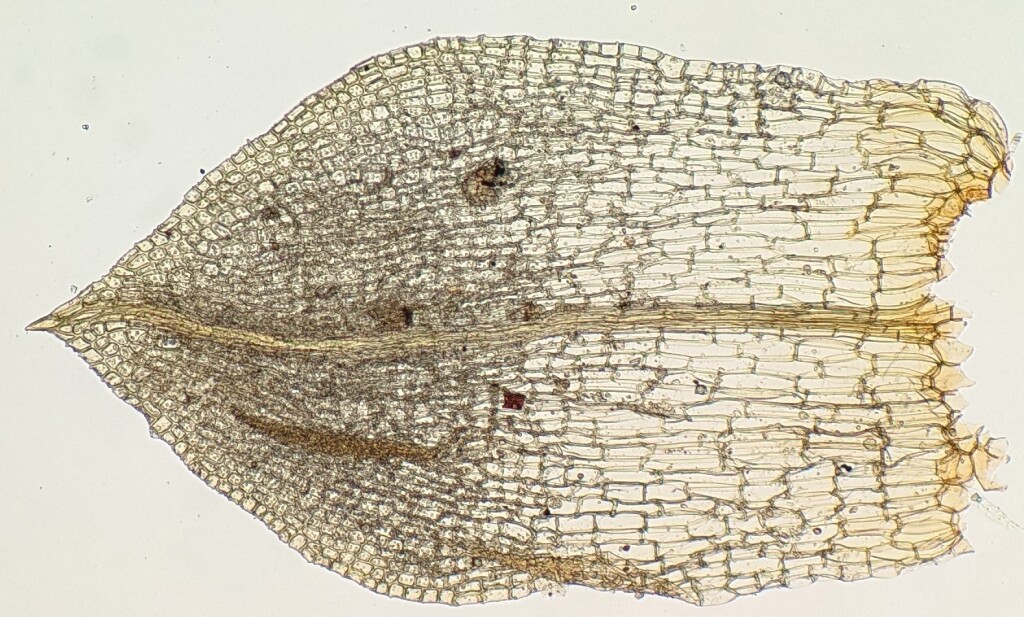Tortula
Autoicous, paroicous, gonioautoicous (not in Victoria) or dioicous. Asexual reproduction by rhizoidal tubers. Cushions or turves on soil or rocks. Stem often branched, with rhizoids at base; central strand present or rarely absent (not in Victoria); sclerodermis absent; hyalodermis absent. Leaves usually ovate to lingulate or spathulate, occasionally orbicular, obovate, linear, oblong or elliptic, erect- to wide-spreading when moist, incurved to spirally twisted when dry; apex rounded, emarginate, obtuse or acute, with or without a hairpoint; costa usually excurrent, rarely subpercurrent or percurrent, with quadrate to short-rectangular adaxial superficial cells, with a differentiated adaxial epidermis, usually without an adaxial stereid band, with a hydroid strand, with an abaxial stereid band, with a differentiated abaxial epidermis, with short-rectangular to elongate abaxial superficial cells; margin entire or rarely denticulate near apex, revolute to recurved, occasionally plane, sometimes with a border of thicker-walled cells, less papillose cells or more elongate cells (not in Victoria), uni- or bistratose (not in Victoria); laminal cells in apical half quadrate, short-rectangular or hexagonal, sometimes rhomboid or oblate, smooth or uni- or pluripapillose on both surfaces, with a yellow or occasionally red KOH reaction; basal laminal cells differentiated equidistant from base from margin to costa or occasionally extending further near costa, rectangular, smooth. Acrocarpous. Capsule erect, rarely inclined to pendent (not in Victoria), straight or curved (not in Victoria), turbinate, hemispheric, ellipsoid, ovoid, oblong or cylindric, exserted, operculate, with a revoluble annulus or without an annulus. Operculum conic or rostrate. Calyptra cucullate, smooth, glabrous. Peristome absent, rudimentary or of 16 perforated (not in Victoria) or deeply divided teeth or 32 entire filaments, twisted anticlockwise or straight.
Around 140 species worldwide except Antarctica and most diverse in northern temperate regions; five species in Victoria.
Zander (1993) included Desmatodon, Phascum and Pottia within Tortula, but retained other genera as separate that he recognised as being morphologically similar such as Crossidium and Pterygoneurum. All these genera have since been shown to be closely related with sampled species from these genera intermixed among each other in a group in phylogenies of chloroplast rps4 DNA sequences (Werner et al. 2002). Consequently, it is likely that the circumscription of Tortula will need to be revised to include all these genera. However, phylogenetic reconstruction of this group of mosses is still in its infancy with few species having been sampled and only one chloroplast region having been sequenced. Revision of this group ideally should be conducted upon confirmation of relationships among this group using phylogenetic analyses of addition DNA regions (Stech et al. 2012). Until this occurs, Tortula is described in a narrower circumscription here, similar to that recognised by Zander (1993), but excluding Phascum, which in Victoria contains species without combinations in Tortula.
 Spinning
SpinningSynonyms
Stech, M.; McDaniel, S.F.; Hernández-Maqueda, R.; Ros, R.M.; Werner, O.; Muñoz, J.; Quandt, D (2012). Phylogeny of haplolepideous mosses – challenges and perspectives. Journal of Bryology 34: 173–186.
Werner, O.; Ros, R.M.; Cano, M.J.; Guerra, J. (2002). Tortula and some related genera (Pottiaceae, Musci): phylogenetic relationships based on chloroplast rps4 sequences. *Plant Systematics and Evolution * 235: 197–207.
Zander, R.H. (1993). Genera of the Pottiaceae: Mosses of harsh environments. Bulletin of the Buffalo Society of Natural Sciences 32: 1–378.

